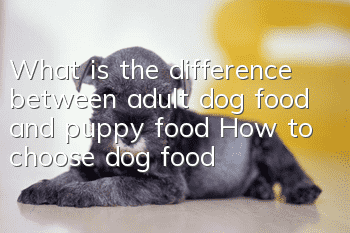What is the difference between adult dog food and puppy food? How to choose dog food?

Dog food standards: AAFCO
When it comes to dog food standards, you have to mention AAFCO.AAFCO’s Chinese name is: American Association of Feed Control Officials.
AAFCO had little control over the pet food market before 1956, and the first person to make recommendations on pet nutrition was the National Research Council (NRC). However, the NRC only writes out the simplest nutrient requirements and does not recommend which foods to obtain. AAFCO also takes into consideration the “ingredients” from which nutrients are derived. So AAFCO defines raw materials such as meat, poultry, meat by-product, poultry meal, etc. At the same time, he also recommended the basic nutritional requirements for dogs and cats based on the NRC report, and each pet food company then used this recommended requirement to design their own pet food content. Usually pet food companies will set the nutrition provided by their pet food higher than the basic requirements locked by AAFCO to ensure that they can meet the requirements.
It can be said that AAFCO ingredient standards are the reference standards for measuring the nutrition of imported pet foods. To put it simply, the minimum nutritional standards must meet the AAFCO standards, and only then can the food be eaten by cats and dogs. Cats and dogs will not have any problems if they eat it.
Domestically, this standard can also be followed, but there is a prerequisite - as long as there is no deception.
Details of dog food classification for each age group
Like people, dogs also have childhood, youth, middle age and old age, as well as fat and Thin man. Naturally, dog food specially designed for dogs in various stages has emerged. So what's the difference between them?
This table is the minimum standard for judging nutritional value provided by AAFCO for adult dogs and puppies, mainly reflected in protein and fat.
Puppies generally refer to dogs under 12 months of age. Due to slower development of large dogs, it is delayed to 15 months.
Adult dogs generally refer to dogs over 12 months old, and so on for large dogs.
According to AAFCO standards, puppy food must contain more than 22.5% protein and more than 8.5% fat. Adult dog food should contain more than 18% protein and more than 5.5% fat.
The above are just the minimum standards! ! The above are just the minimum standards! ! The above are just the minimum standards! !
As for low-fat food, according to some foreign statistics and veterinarians, the fat is less than 12%, which is among normal dog food and can be regarded as low-fat food.
Summary: Dog food for various periods of time is basically divided according to protein and fat content. For dog food of the same brand and grade, the protein and fat of puppy food will be significantly higher than that of adult dogs (the price is also the same)
The difference between adult dog and puppy food
As mentioned above, dog food of various periods is basically divided into categories according to the protein and fat content.Since adult dogs have smaller nutritional needs than young dogs and are at risk of gaining weight, the protein and fat of adult dog food will be relatively low.
- Is it better for Dogo dogs to have their ears erect or cropped? A case of Dogo dog’s ear erection surgery will tell you
- What do dogs eat to protect their stomach? It is important to protect their stomach and treat gastrointestinal diseases in dogs.
- How to tell if your dog is fat? Is your dog overweight?
- Will your dog catch a cold if you blow the air conditioner? What should you do if your dog catches a cold if you blow the air conditioner?
- What should you pay attention to when your dog drinks water? Don’t be careless when it comes to your dog’s drinking water.
- The dog's mouth bites and shakes. Why does the dog's mouth occasionally shake and bite?
- How to cut a dog's hair? Do you know how to cut a dog's hair correctly?
- Can dogs eat raw eggs? Why can’t dogs eat egg whites?
- Common Dog Problems in Summer How to Deal with Different Dog Problems
- How to keep dogs away from skin diseases. If you do this, will you see if your dog will still be infected with skin diseases?



